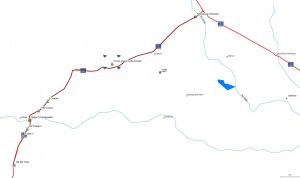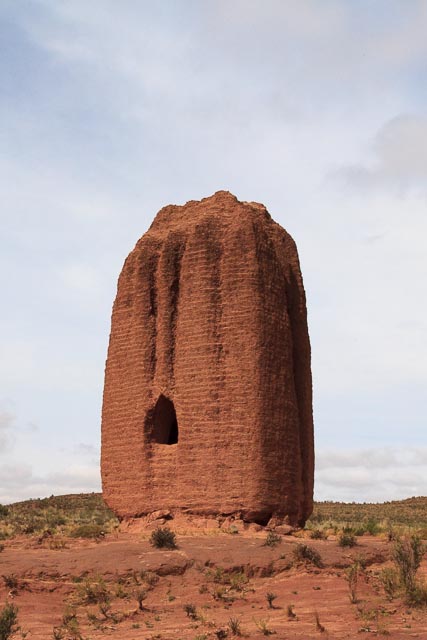Chulpas Near Curahuara de Carangas
Chulpas (also Chullpas), the tombs of the ancestral peoples of the altiplano, are found almost everywhere on the high plains of Bolivia. They seem to be particularly common along the road to Curahuara de Carangas. There are many Chulpas, and I see more every time I take the road, so if you keep your eyes pealed, you will probably find some that are not on the map below.
Chulpas are a particular feature of the altiplano. Apparently adopted as a form of burial by the Aymara peoples in the aftermath of the fall of the Tiwanaku culture (1000 to 1100 AD), the tradition of burying important leaders (Mallkus) above ground (usually, sometimes a burial chamber was dug under the chulpa) in a funeral tower spread widely through the Aymara culture and to some other peoples in the area.
The purpose of the chulpa seems to have been both a matter of demonstrating respect and admiration for a particularly powerful deceased leader, and providing a place for that leader to be venerated and worshiped. Chulpas were constructed in areas held sacred by the builders. They contained the remains of the leader, often objects of particular value (either intrinsic or emotional/spiritual) which belonged to the leader, the remains of family members, and sometimes the remains of servants, who were often killed in order to provide company to their masters in the afterlife. Of course, all or most (probably all) chulpas have long since been sacked and at this point contain, if they contain anything, only a few dry bones.
 Chulpas take various shapes and can be made of a variety of different building materials. We have visited Chulpas near the Salar de Uyuni, at Cerro Pirapi and the Chulpas Policromas south of Sajama National Park. In comparison with some of these, the chulpas of the Curahuara area are relatively modest, constructed of adobe, but are nonetheless imposing towers usually set on ridges or hills over the altiplano. The small doors of the chulpas can vary in shape and size, but generally face east. Those which do not face east are usually considered to have been constructed by non-Aymara peoples.
Chulpas take various shapes and can be made of a variety of different building materials. We have visited Chulpas near the Salar de Uyuni, at Cerro Pirapi and the Chulpas Policromas south of Sajama National Park. In comparison with some of these, the chulpas of the Curahuara area are relatively modest, constructed of adobe, but are nonetheless imposing towers usually set on ridges or hills over the altiplano. The small doors of the chulpas can vary in shape and size, but generally face east. Those which do not face east are usually considered to have been constructed by non-Aymara peoples.
 The area between Patacamaya and Curahuara is particularly well known for chulpas. Off the main road of our trip (and I have not visited these yet) are the Kulli Kulli City of Chulpas near Ayamaya and the Chulpas of Tolerani near Umala.
The area between Patacamaya and Curahuara is particularly well known for chulpas. Off the main road of our trip (and I have not visited these yet) are the Kulli Kulli City of Chulpas near Ayamaya and the Chulpas of Tolerani near Umala.
The first chulpas visible from the road on this trip will come into view to your right at about mile 15 from the Patacamaya checkpoint. These are part of a complex of chulpas, chulpas of Cóndor Amaya, which covers about five square miles, mostly to the north (right side) of the road. For the next 20 miles you will continue to see chulpas on both sides of the road. Those I have noticed are labeled on the map and in the attached .gdb file. At about 25 miles from the checkpoint, you will see the ruins of a bell tower to the right of the road. For all practical purposes, the bell tower marks the boundary between La Paz and Oruro Departments. At this point, you are only some 6 miles from the first of the colonial-era chapels this guide focuses upon, Huchusuma Chapel.
Posted: November 17th, 2013 under Altiplano, Archeology, Bolivia, Day Trip, GPS, Mapping, Oruro, South America, Travel.
Tags: Altiplano, Bolivia, Day Trip, GPS, La Paz, Mapping, Travel
Comments
Write a comment
You need to login to post comments!


Pingback from Larry Memmott's Blog » The Churches of Curahuara de Carangas and Sajama: La Paz to Tomarapi
Time November 28, 2013 at 5:35 pm
[…] from the checkpoint which you pass as you leave Patacamaya, you’ll begin to see the many Aymara burial towers, called chulpas, on the ridge in front of you on both sides of the road. There are chulpas scattered all over the […]